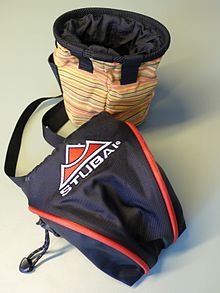Magnesia bag
A Magnesiasack , chalk bag or English chalkbag , in larger embodiments also Pot called, is a small bag filled with magnesia for use in rock climbing . The mostly cylindrical sack is spread open by a stiff plastic ring in the hem of the opening, is ideally lined with fleece on the inside and can be closed dust-tight for transport by a cord with tanka in a hem that runs a little deeper around this lining. When open, there should be room for a whole hand. It is used to dry hands that are damp from sweat by reaching into the sack filled with magnesia powder during climbing and thus to achieve better friction between skin and rock. Most magnesia bags also have a flap on the side, in which a toothbrush can be carried for cleaning handles.
The magnesia carried in the chalk bag is the chemical compound magnesium carbonate . It is available in powder form, in the form of blocks that are crushed, as a chalk ball (that is, the powder is in a thin, permeable ball of substance) and recently also in liquid form suspended in alcohol.
The climber usually hangs the magnesia bag at the back of the tailbone with a small carabiner on the climbing harness or with a narrow strap on the hip. The place where it is hung at the back of the hip is the most favorable because the climber can reach in and dry (so-called chalking or re-chalking) with either hand and can still stay close to the rock with his hip.
In contrast to the normal magnesia sack, the pot, as a large magnesia sack that several climbers can reach into at the same time, is not attached to the climber. Especially when bouldering, it serves as a chalk bag for several users to stand on the ground.
There are a variety of different models in a wide variety of colors and shapes. Which choice is made depends not only on functional aspects, but also on personal preferences and aesthetic factors.
literature
- Matt Burbach: Gym Climbing: Maximizing your Indoor Experience . 1st edition. Mountaineers Books, Seattle 2004, ISBN 978-0-89886-742-8 , pp. 41 .
- Turlough Johnston, Madeleine Hallden: Adventure sport climbing. Equipment, technology, training . Sportverlag, Berlin 1995, ISBN 3-328-00656-7 , p. 71 .
Web links
- Chalk bags. indoorclimbing.com (English)
- How to Use Indoor Rock Climbing Chalk Bags. Video

